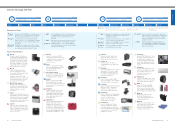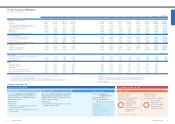Omron 2013 Annual Report Download - page 20
Download and view the complete annual report
Please find page 20 of the 2013 Omron annual report below. You can navigate through the pages in the report by either clicking on the pages listed below, or by using the keyword search tool below to find specific information within the annual report.
36 Omron Corporation Integrated Report 2013 37
Where We're Headed
events in which consumers can have their blood
pressure tested for free, and we are also broadcast-
ing commercials featuring characters that appeal to
the populous. As a result of these efforts, 60% of
consumers recognize Omron as a company that
helps prevent and treat lifestyle-related diseases. In
addition, after the Lushan earthquake in April 2013,
we donated approximately 500 blood pressure moni-
tors as relief items to help support the victims of the
earthquake.
I believe that efforts such as these are contribut-
ing to improved recognition of the Omron brand.
Similarly, in India, we employ outdoor advertise-
ments, participate in health-related events, and are
otherwise working to improve brand recognition of
the entire Omron Group.
Umeda: In terms of competition, we have to com-
pete with local companies and many other rivals. In
such an environment, it is not enough to simply sell
our products. We must continue to meet the mar-
ket’s needs for evidence and quality while also
retaining necessary approval, all of which represent
hurdles to be cleared if we are to further develop
our operations. This is no easy task, and even man-
ufacturers from Europe and the United States are
having diffi culty accomplishing it.
Ozeki: In recent years, Chinese and South Korean
manufacturers have been a rapidly growing pres-
ence. These manufacturers all share a strong entre-
preneurial spirit committed to cutting open new
markets. However, these manufacturers still only
provide consumer goods. Conversely, Omron not
only offers consumer goods, it also has a robust
lineup of products for medical institutions. In addi-
tion, we are conducting clinical evaluations with
medical practitioners and educational activities tar-
geting pharmacists.
Our ability to promote the Omron brand as a
brand for medical professionals—equating Omron’s
blood pressure monitors with cardiovascular dis-
eases, nebulizers with respiratory illnesses, and
blood glucose monitors with endocrine system
diseases—is a powerful tool for differentiating HCB.
For example, in China, we worked on guidelines for
hypertension in cooperation with the Chinese Soci-
ety of Hypertension.
I believe that strengthening our relationship with
local academic circles pertaining to medical institu-
tions and medical practitioners is an important point
to consider when advancing into the markets of
emerging countries.
I also must say that I am always surprised at how
many government or academic leaders create
opportunities to meet with us whenever we visit
Asian countries.
— What factors do you think have contributed to
this warm reception?
Ozeki: It is most likely a result of the reputation
that accompanies our leading share in the global
market for blood pressure monitors. In addition,
the factory automation technologies of Industrial
Automation Business (IAB) are garnering a great
deal of attention in government sectors. In this
manner, both IAB and HCB have established strong
reputations in society.
Economic Value Creates Social Value
— What is the situation regarding environmental
issues in emerging countries?
Ozeki: As one initiative of China’s Twelfth Five-Year
Guideline (2011–2015), mercury was banned for use
in industrial applications, and it is expected that the
Thirteenth Five-Year Guideline will forbid the use of
mercury for medical applications. A similar guide-
line was established in India just recently. For this
reason, I feel that offering clinical-minded support
to these countries in making the switch from the
mercury-based blood pressure monitors to elec-
tronic monitors will create economic value and
social value.
By leveraging the blood pressure monitors for
which Omron holds the top share in the global
market, we have established a sales network
consisting of approximately 110,000 stores
throughout Asia. The way in which our products
are being sold and bought mainly in drug stores,
the downstream end of the distribution chain,
is of utmost importance.
Each store serves as an opportunity for custom-
ers to become acquainted with Omron. As such,
we are actively holding product explanation semi-
nars for store staff and implementing other initia-
tives to make better use of these opportunities.
Further, if we are to contribute to improved health
among the populous, we have to supply our prod-
ucts to a wide range of customers. However, this
means that we must address more demanding
expectations with regard to product specifi cations
and prices. To help guide a wider range of custom-
ers to our products, we offer extensive advice to
stores, which serve as opportunities for customers
to encounter our products. This advice goes as far
as to make suggestions regarding product displays.
This type of steadfast effort has led us to obtain the
leading share of more than 60% for blood pressure
monitors in India.
— How high is Omron’s brand recognition in
emerging countries? Also, what competition does
Omron face?
Ozeki: We are actively conducting branding activities
in these countries. For example, in China, we hold
Our mission is to help treat people
with respiratory illnesses
in Asia and around the world.
Toru Ozeki
It is not enough to just provide
equipment; I want to provide proper
treatment environments as well.
Masahiro Umeda
— How is economic support for healthcare in
emerging countries?
Ozeki: While the range of healthcare services
offered under health insurance is gradually expand-
ing in emerging nations, we are also seeing a
rise in the number of sufferers of chronic malady,
including such representative examples of this
ailment as asthma and COPD. Accordingly, the
spread of nebulizers, which enable patients to
undergo inhalation-based treatments at home,
will make signifi cant contributions to establishing
a sound balance between health insurance and
public fi nances in these countries. It could be seen
as Omron’s mission to help drive the spread of
nebulizers in emerging countries through pricing
measures and educational activities.
Umeda: Prior, I spoke of mesh nebulizers and com-
pressor nebulizers that employed blood pressure
monitor pumps. These are no doubt revolutionary
products, but they still face issues with regard to
price and maintenance procedures. We are currently
in the process of developing new products to
address these remaining issues, and it is my hope
that we will be able to develop new products that
change the very defi nition of nebulizers.
— In closing, what are your wishes and goals for the
future?
Umeda: There are still countless people around the
world that are unable to receive proper treatment
of asthma and COPD. However, for these people, it
is not enough to just provide equipment; I want to
provide proper treatment environments.
Ozeki: Our mission is to help treat people with
respiratory illnesses around the world. To fulfi ll this
mission, we are improving the capabilities of each
product in our rich lineup and raising brand recogni-
tion to enable Omron’s products to better contrib-
ute to the resolution of the health issues of people
around the world. Currently, more than 30% of
HCB’s earnings are generated in Asia, and we have
the goal of achieving a 50% increase from fi scal
2012 sales in this region by 2020.
Storefront in India
Educational forum for distributor in India
























